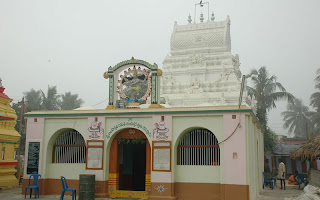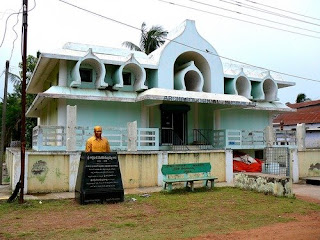Gottipati Brahmaiah: Gottipati Brahmaiah or Gottipati Brahmayya was a freedom fighter, popularly known as Ryotu Pedda (Leader of Farmers). He was awarded the Padma Bhushan in 1982. Born in Ghantasala (Divi Taluka of Krishna district) in Andhra Pradesh, India. he was educated at Noble High School, Machilipatnam, he organized the library movement and the adult education movement in 1917. He was also the President of District Congress Committee during 1922-1923. He was the founder of the Khadi Consumers' and Producers' Society at Ghantasala and became President of Krishna Khadi Board during 1923-1929.
Brahmaiah was one of the pioneers of the Zamindari Ryot Movement. He participated in the boycott of the Simon Commission in 1927. He was sentenced to rigorous imprisonment for one year and six months in 1930 for participating in the black flag demonstration against the then Governor’s visit to Machilipatnam.[citation needed] He suffered imprisonment in Rajahmundry, Berhampore and Vellore jails. He again took part in the Civil disobedience movement and was sentenced to two years of rigorous imprisonment in Rajahmundry, Bellary, Madras and Cuddalore jails. He was responsible for the temple entry of Harijans at Ghantasala in 1933. He was General Secretary of Andhra Provincial Congress Committee during 1937-1940. He was again detained for participating in Quit India movement in 1942 and placed in Vellore and Thanjavur prisons.
After independence, Mr Brahmaiah became President of Andhra Pradesh Congress Committee in 1962. He served as Chairman of Andhra Pradesh Legislative Council from 1964 to 1968. Mr.Brahmaiah was conferred with a doctrate "Kalaprapoorna" by Andhra University. Mr Brahmaiah 's autobiography "Naa Jeevana Nauka" is well read and was published in a leading telugu daily "Andhra Jyothi" in Late 1970s.
U.V. Warlu: Shri Uppala Venkateswarlu, popularly known as “U.V. Warlu” was born in Ghantasala Village, Krishna Dist., AP on 16th December, 1927. After Graduation he did his DMIT (now B.Tech) from Madras Institute of Technology with distinction and 2nd rank.
Shri U.V. Warlu was Vice-President and Chairman, Apex Forum of IETE 2003-04. He was the Chairman of the Centre for the record four terms i.e. for the year 1984-85, 1985-86, 1990-91 and 1991-92. He has been elected to the IETE Council as a Member and served as Vice-President for the year 1985-87, 1997-2000 and 2001-2004. In admiration of his services to the Electronic Industry in general and IETE, Hyderabad Centre in particular the annual Endowment Lecture has been instituted in his name in the year 1996. So far, nine lectures were organized in the IETE at Hyderabad. Shri U.V. Warlu’s contribution to the IETE, Hyderabad Centre has been immense.
He served as Chairman for 12 leading Companies. Shri U.V. Warlu went abroad several times either for training or as a Member of study groups or as adviser for presenting papers at International conventions etc. He was Chairman of numerous Committees / Panels / Working groups appointed by DAE, DOE, DST, DNES etc. He has published around 15 technical papers and around 20 policy papers on Electronics and Energy subjects. Shri Warlu was the first recipient of the Nayudamma Award in 1986 for services in the area of Electronics and Energy by Indo-Japanese Friendship Association. With an objective to promote educational facilities in the State Shri Warlu has established a Foundation called “Warlu Educational Foundation”. To begin with, in token of his love for his native village, Shri Warlu has established an Industrial Training Centre at Ghantasala which started functioning from 1997-98.
He has been instrumental for the tremendous progress made by this Centre. Shri U.V. Warlu passed away on 2nd October, 2004. The Hyderabad Centre of the IETE lost a great visionary and an elderly guide.





































